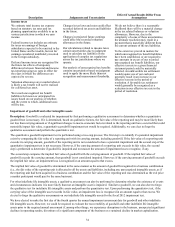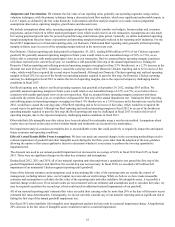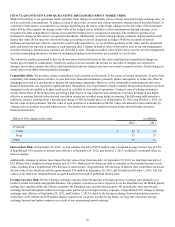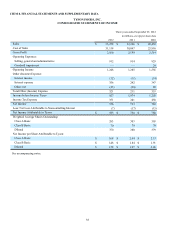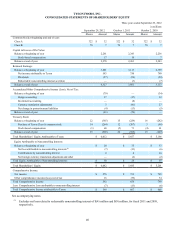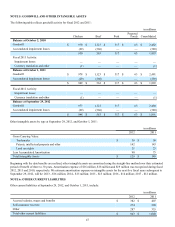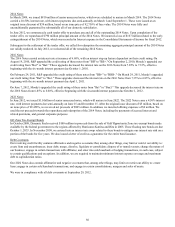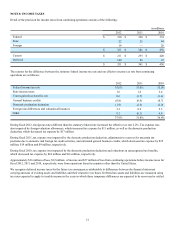Tyson Foods 2012 Annual Report Download - page 44
Download and view the complete annual report
Please find page 44 of the 2012 Tyson Foods annual report below. You can navigate through the pages in the report by either clicking on the pages listed below, or by using the keyword search tool below to find specific information within the annual report.
44
Variable Interest Entity: We have an investment in a joint venture, Dynamic Fuels LLC (Dynamic Fuels), in which we have a 50%
ownership interest. Dynamic Fuels qualifies as a variable interest entity for which we consolidate as we are the primary beneficiary. At
September 29, 2012, Dynamic Fuels had $177 million of total assets, of which $146 million was net property, plant and equipment,
and $124 million of total liabilities, of which $100 million was long-term debt. At October 1, 2011, Dynamic Fuels had $170 million
of total assets, of which $144 million was net property, plant and equipment, and $116 million of total liabilities, of which $100
million was long-term debt.
Accrued Self Insurance: We use a combination of insurance and self-insurance mechanisms in an effort to mitigate the potential
liabilities for health and welfare, workers’ compensation, auto liability and general liability risks. Liabilities associated with our risks
retained are estimated, in part, by considering claims experience, demographic factors, severity factors and other actuarial
assumptions.
Capital Stock: We have two classes of capital stock, Class A Common Stock, $0.10 par value (Class A stock) and Class B Common
Stock, $0.10 par value (Class B stock). Holders of Class B stock may convert such stock into Class A stock on a share-for-share basis.
Holders of Class B stock are entitled to 10 votes per share, while holders of Class A stock are entitled to one vote per share on matters
submitted to shareholders for approval. As of September 29, 2012, Tyson Limited Partnership (the TLP) owned 99.977% of the
outstanding shares of Class B stock and the TLP and members of the Tyson family owned, in the aggregate, 2.53% of the outstanding
shares of Class A stock, giving them, collectively, control of approximately 71.52% of the total voting power of the outstanding voting
stock. Cash dividends cannot be paid to holders of Class B stock unless they are simultaneously paid to holders of Class A stock. The
per share amount of the cash dividend paid to holders of Class B stock cannot exceed 90% of the cash dividend simultaneously paid to
holders of Class A stock. We pay quarterly cash dividends to Class A and Class B shareholders. We paid Class A dividends per share of
$0.16 and Class B dividends per share of $0.144 in each of fiscal years 2012, 2011 and 2010.
The Class B stock is considered a participating security requiring the use of the two-class method for the computation of basic
earnings per share. The two-class computation method for each period reflects the cash dividends paid for each class of stock, plus the
amount of allocated undistributed earnings (losses) computed using the participation percentage, which reflects the dividend rights of
each class of stock. Basic earnings per share were computed using the two-class method for all periods presented. The shares of Class
B stock are considered to be participating convertible securities since the shares of Class B stock are convertible on a share-for-share
basis into shares of Class A stock. Diluted earnings per share were computed assuming the conversion of the Class B shares into
Class A shares as of the beginning of each period.
On May 11, 2011, we announced our Board of Directors reactivated a share repurchase program, which had no activity since fiscal
2005, to repurchase up to the remaining available 22.5 million shares of Class A common stock under the program. In May 2012, our
Board of Directors approved an increase of 35 million shares authorized for repurchase under our share repurchase program. As of
September 29, 2012, 35.2 million shares remained available for repurchase. The share repurchase program has no fixed or scheduled
termination date and the timing and extent to which we repurchase shares will depend upon, among other things, our working capital
needs, market conditions, liquidity targets, our debt obligations and regulatory requirements. In addition to the share repurchase
program, we purchase shares on the open market to fund certain obligations under our equity compensation plans.
A summary of cumulative share repurchases of our Class A Stock is as follows (in millions):
September 29, 2012 October 1, 2011 October 2, 2010
Shares Dollars Shares Dollars Shares Dollars
Shares repurchased:
Under share repurchase program 12.5 $ 230 9.7 $ 170 — $ —
To fund certain obligations under equity compensation plans 1.8 34 2.0 37 3.2 48
Total share repurchases 14.3 $ 264 11.7 $ 207 3.2 $ 48


